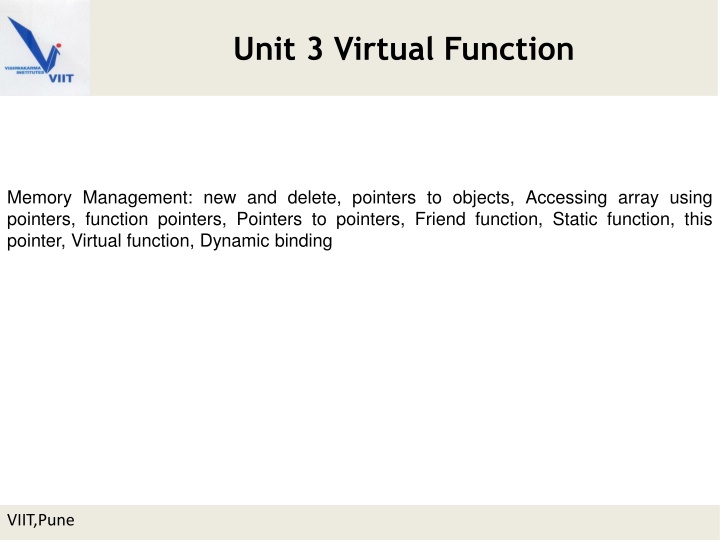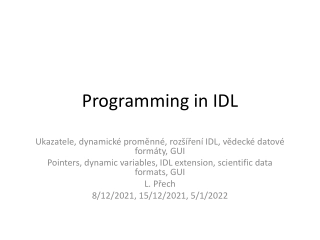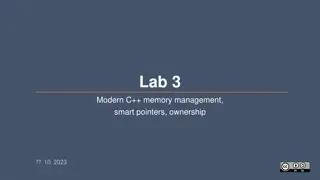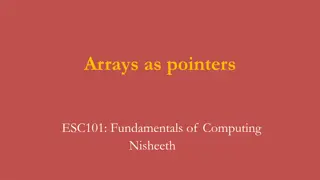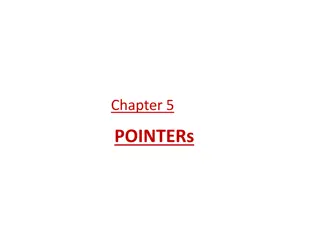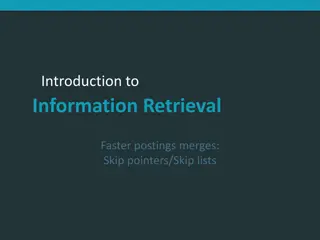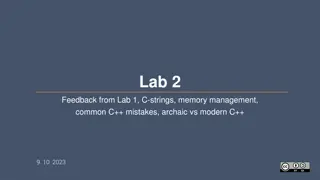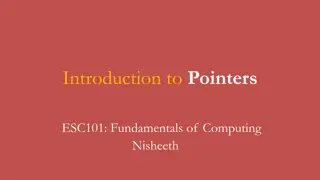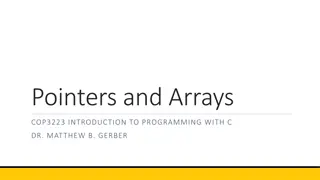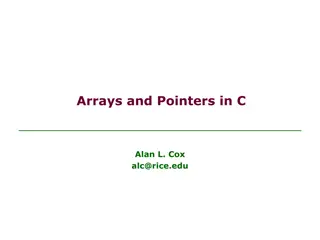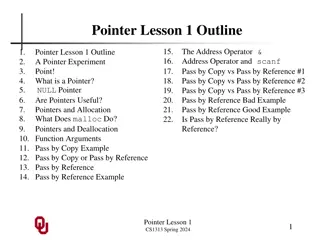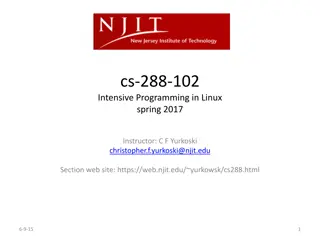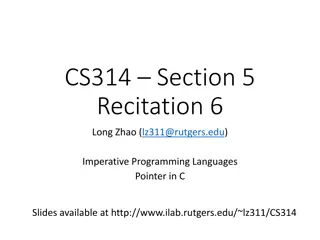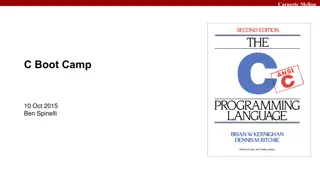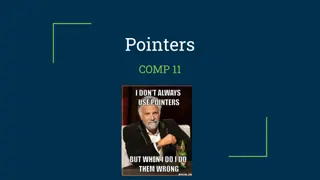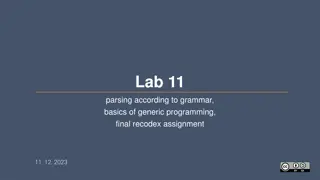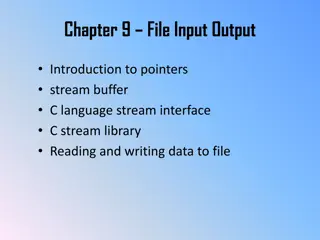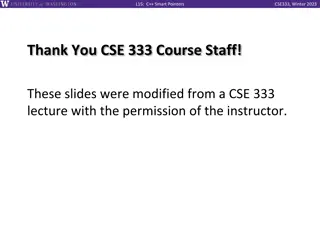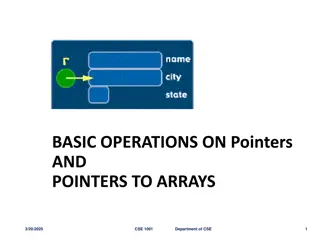Essential Concepts in C/C++ Pointers for Effective Programming
Pointers in C/C++ are powerful tools for memory management and accessing data efficiently. Learn about pointer variables, declarations, operators, and their significance in object-oriented programming. Understand how to avoid common pitfalls with uninitialized pointers and utilize pointers effectively for dynamic memory allocation.
Download Presentation

Please find below an Image/Link to download the presentation.
The content on the website is provided AS IS for your information and personal use only. It may not be sold, licensed, or shared on other websites without obtaining consent from the author.If you encounter any issues during the download, it is possible that the publisher has removed the file from their server.
You are allowed to download the files provided on this website for personal or commercial use, subject to the condition that they are used lawfully. All files are the property of their respective owners.
The content on the website is provided AS IS for your information and personal use only. It may not be sold, licensed, or shared on other websites without obtaining consent from the author.
E N D
Presentation Transcript
Unit 3 Virtual Function Memory Management: new and delete, pointers to objects, Accessing array using pointers, function pointers, Pointers to pointers, Friend function, Static function, this pointer, Virtual function, Dynamic binding VIIT,Pune
Contents Virtual Functions- Pointers- indirection Operators Memory Management: new and delete Pointers to Objects A Linked List Example accessing Arrays using pointers Function pointers Pointers to Pointers A Parsing Example Debugging Pointers Dynamic Pointers Object Oriented Programming VIIT,Pune
Contents smart pointers shared pointers Case Study : Design of Horse Race Simulation Virtual Function- Friend Functions Static Functions Assignment and Copy Initialization this Pointer virtual function dynamic binding Virtual destructor Object Oriented Programming VIIT,Pune
Pointers Pointers are one of the strongest features in C/C++ Pointer is a variable that holds a memory address. This address is the location of another object (typically another variable) in memory. Uninitialized pointers (or pointers containing invalid values) can cause your system to crash. Object Oriented Programming VIIT,Pune
Pointer Variables A pointer declaration consists of a base type, an *, and the variable name. The general form for declaring a pointer variable is type *var-name; Type may be any valid type. E.g. int *ip; // pointer to an integer double *dp; // pointer to a double float *fp; // pointer to a float char *ch // pointer to character The name of the pointer variable is specified by name The base type of the pointer defines what type of variables the pointer can point to. Technically, any type of pointer can point anywhere in memory The actual data type of the value of all pointers, whether integer, float, character, or otherwise, is the same, a long hexadecimal number that represents a memory address
Pointer Operators There are two special pointer operators: * and &. The & is a unary operator that returns the memory address of its operand. m = &count; places into m the memory address of the variable count. This address is the computer's internal location of the variable. It has nothing to do with the value of count. You can think of & as returning "the address of." Therefore, the preceding assignment statement means "m receives the address of count." Object Oriented Programming VIIT,Pune
Pointer Operators The second pointer operator, *, is the complement of &. It is a unary operator that returns the value located at the address that follows. For example, if m contains the memory address of the variable count, q = *m; places the value of count into q. Both & and * have a higher precedence than all other arithmetic operators except the unary minus, with which they are equal. Object Oriented Programming VIIT,Pune
using namespace std; int main () { int var = 20; int *ip; ip = &var; cout << "Value of var variable: "; cout << var << endl; // print the address stored in ip pointer variable cout << "Address stored in ip variable: "; cout << ip << endl; // access the value at the address available in pointer cout << "Value of *ip variable: "; cout << *ip << endl; return 0; } // actual variable declaration. // pointer variable // store address of var in pointer variable Value of var variable: 20 Address stored in ip variable: 0xbfc601ac Value of *ip variable: 20
Pointer Expressions In general, expressions involving pointers conform to the same rules as other expressions Pointer Assignments As with any variable, you may use a pointer on the right- hand side of an assignment statement to assign its value to another pointer. Object Oriented Programming VIIT,Pune
Pointer Assignments #include <stdio.h> int main(void) { int x; int *p1, *p2; p1 = &x; p2 = p1; printf(" %p", p2); /* print the address of x, not x's value! */ return 0; } Both p1 and p2 now point to x. The address of x is displayed by using the %p printf( ) format specifier, which causes printf( ) to display an address in the format used by the host computer.
Pointer Arithmetic There are only two arithmetic operations that you may use on pointers: addition and subtraction. let p1 be an integer pointer with a current value of 2000. Also, assume integers are 2 bytes long. After the expression p1++; p1 contains 2002, not 2001 Object Oriented Programming VIIT,Pune
Pointer Arithmetic The same is true of decrements. For example, assuming that p1 has the value 2000, the expression p1--; causes p1 to have the value 1998. When applied to character pointers, this will appear as "normal" arithmetic because characters are always 1 byte long. You are not limited to the increment and decrement operators. For example, you may add or subtract integers to or from pointers. p1 = p1 + 12; Object Oriented Programming VIIT,Pune
Pointer Arithmetic Object Oriented Programming VIIT,Pune
Pointer Comparisons You can compare two pointers in a relational expression. For instance, given two pointers p and q, if(p<q) printf("p points to lower memory than q\n"); pointer comparisons are used when two or more pointers point to a common object, such as an array Object Oriented Programming VIIT,Pune
Example #include <stdio.h> #include <stdlib.h> #define SIZE 50 do { } printf("Enter value: "); scanf("%d", &value); if(value!=0) push(value); else printf("value on top is %d\n", pop()); } while(value! = -1); return 0; void push(int i); int pop(void); int *tos, *p1, stack[SIZE]; void push(int i) { *p1 = i; } int main(void) { p1++; if(p1 == (tos+SIZE)) { printf("Stack Overflow.\n"); exit(1); } int value; tos = stack; /* tos points to the top of p1 = stack; /* initialize p1 */ stack */ Object Oriented Programming VIIT,Pune
Example(Continue..) int pop(void) { } In pop( ), the parentheses are necessary in the return statement. Without them, the statement would look like this: return *p1 +1; if(p1==tos) { } p1--; return *(p1+1); printf("Stack Underflow.\n"); exit(1); which would return the value at location p1 plus one, not the value of the location p1+1. Object Oriented Programming VIIT,Pune
Array elements can be accessed using pointer notation as well as array notation. // ptrnote.cpp // array accessed with pointer notation #include <iostream> using namespace std; int main() { //array int intarray[5] = { 31, 54, 77, 52, 93 }; for(int j=0; j<5; j++) //for each element, cout << *(intarray+j) << endl; //print value return 0; } The C++ compiler is smart enough to take the size of the data into account when it performs arithmetic on data addresses. It knows that intarray is an array of type int because it was declared that way. So when it sees the expression intarray+3, it interprets it as the address of the fourth integer in intarray, not the fourth byte.
EXAMPLE 2 #include <iostream> using namespace std; int main () { // an array with 5 elements. double balance[5] = {1000.0, 2.0, 3.4, 17.0, 50.0}; double *p; p = balance; // output each array element's value cout << "Array values using pointer " << endl; for ( int i = 0; i < 5; i++ ) { cout << "*(p + " << i << ") : "; cout << *(p + i) << endl; } cout << "Array values using balance as address " << endl; for ( int i = 0; i < 5; i++ ) { cout << "*(balance + " << i << ") : "; cout << *(balance + i) << endl; } return 0; }
Array values using pointer *(p + 0) : 1000 *(p + 1) : 2 *(p + 2) : 3.4 *(p + 3) : 17 *(p + 4) : 50 Array values using balance as address *(balance + 0) : 1000 *(balance + 1) : 2 *(balance + 2) : 3.4 *(balance + 3) : 17 *(balance + 4) : 50
Pointers and Functions Three ways to pass arguments to a function: by value, by reference, and by pointer. If the function is intended to modify variables in the calling program, these variables cannot be passed by value, since the function obtains only a copy of the variable. However, either a reference argument or a pointer can be used in this situation.
// arguments passed by reference #include <iostream> using namespace std; int main() { void centimize(double&); //prototype double var = 10.0; //var has value of 10 inches cout << var = << var << inches << endl; centimize(var); //change var to centimeters cout << var = << var << centimeters << endl; return 0; } //-------------------------------------------------------------- void centimize(double& v) //It simply uses the argument name v; v and var are different names for the same thing. { v *= 2.54; //v is the same as var }
// passptr.cpp // arguments passed by pointer #include <iostream> using namespace std; int main() { void centimize(double*); // argument is pointer to double double var = 10.0; //var has value of 10 inches cout << var = << var << inches << endl; centimize(&var); //it supplies the address of the variable as the argument, this is not the variable itself, as it is in passing by reference, but the variable s address. cout << var = << var << centimeters << endl; return 0; } //-------------------------------------------------------------- void centimize(double* ptrd) //it must use the dereference operator, *ptrd, to access the value stored at this address { *ptrd *= 2.54; //*ptrd is the same as var }
Passing a pointer as an argument to a function is in some ways similar to passing a reference. They both permit the variable in the calling program to be modified by the function. However, the mechanism is different. A reference is an alias for the original variable, while a pointer is the address of the variable.
Passing Arrays varray[0]=25.4 centimeters varray[1]=109.474 centimeters varray[2]=243.586 centimeters varray[3]=151.638 centimeters varray[4]=221.742 centimeters // array passed by pointer #include <iostream> using namespace std; const int MAX = 5; //number of array elements int main() { void centimize(double*); //prototype double varray[MAX] = { 10.0, 43.1, 95.9, 59.7, 87.3 }; centimize(varray); //pass array address for(int j=0; j<MAX; j++) //display new array values cout << varray[ << j << ]= << varray[j] << centimeters << endl; return 0; } //-------------------------------------------------------------- void centimize(double *ptrd) //double * is equivalent here to double[], { for(int j=0; j<MAX; j++) *ptrd++ *= 2.54; //ptrd points to elements of varray }
Pointers to String Constants // strings defined using array and pointer notation #include <iostream> using namespace std; int main() { char str1[] = Defined as an array ; char* str2 = Defined as a pointer ; cout << str1 << endl; // display both strings cout << str2 << endl; // str1++; // can t do this; str1 is a constant str2++; // this is OK, str2 is a pointer cout << str2 << endl; // now str2 starts efined... return 0; } But there is a subtle difference: str1 is an address that is, a pointer constant while str2 is a pointer variable. So str2 can be changed, while str1 cannot,
Static vs. Dynamic Objects Static object (variables as declared in function calls) Memory is acquired automatically Dynamic object Memory is acquired by program with an allocation request new operation Memory is returned automatically when object goes out of scope Dynamic objects can exist beyond the function in which they were allocated Object memory is returned by a deallocation request delete operation Object Oriented Programming VIIT,Pune
Memory Allocation new delete Int *ptr; ptr = new int[200]; delete [] ptr; { int a[200]; } Object Oriented Programming VIIT,Pune
Memory Management Operator new and delete operators are used to allocate and free the memory This versatile operator obtains memory from the operating system and returns a pointer to its starting point. Object can be created by using new and deleted by using delete operator Syntax: // Pointer initialized with NULL // Then request memory for the variable int *p = NULL; p = new int; OR // Combine declaration of pointer // and their assignment int *p = new int; Pointer variable = new data-type
New operator Example Int *p=new int; Float *q=new float; Example: int *p = new int(25); float *q = new float(75.25); Allocate block of memory: new operator is also used to allocate a block(an array) of memory of type data- type. Syntax: Example: int *p = new int[10] pointer-variable = new data-type[size]; Object Oriented Programming VIIT,Pune
Normal Array Declaration vs Using new There is a difference between declaring a normal array and allocating a block of memory using new. The most important difference is, normal arrays are deallocated by compiler (If array is local, then deallocated when function returns or completes). However, dynamically allocated arrays always remain there until either they are deallocated by programmer or program terminates.
Delete operator Example Data object no longer needed, it is destroyed to release memory space for reuse. If your program reserves many chunks of memory using new, eventually all the available memory will be reserved and the system will crash. To ensure safe and efficient use of memory, the new operator is matched by a corresponding delete operator that returns memory to the operating system. Syntax delete pointer variable returns to the system whatever memory was pointed to by ptr. Object Oriented Programming VIIT,Pune Example : delete q; delete p;
// Release block of memory pointed by pointer- variable Syntax : delete[] pointer-variable; Example: // It will free the entire array pointed by p. delete[] p;
int main () { // Pointer initialization to null int* p = NULL; // Request block of memory of size n int n = 5; int *q = new int[n]; if (!q) cout << "allocation of memory failed\n"; else { for (int i = 0; i < n; i++) // Request memory for the variable using new operator p = new int; if (!p) cout << "allocation of memory failed\n"; else { // Store value at allocated address *p = 29; cout << "Value of p: " << *p << endl; } q[i] = i+1; cout << "Value store in block of memory: "; for (int i = 0; i < n; i++) cout << q[i] << "; //*(q+i) } // freed the allocated memory delete p; delete r; float *r = new float(75.25); cout << "Value of r: " << *r << endl; // freed the block of allocated memory delete[] q; Value of p: 29 Value of r: 75.25 Value store in block of memory: 1 2 3 4 5 return 0; }
//EXAMPLE : String with new and delete operator #include <cstring> //for strlen using namespace std; int main() { char *str = Idle hands are the devil s workshop. ; int len = strlen(str); char *ptr; //make a pointer to char //get length of str ptr = new char[len+1]; //set aside memory: string + \0 strcpy(ptr, str); cout << ptr= << ptr << endl; //show that ptr is now in str //copy str to new memory area ptr delete[ ] ptr; //release ptr s memory return 0; }
Pointers to Object(Continue..) Object pointers are useful in creating objects at run time. Used to access public members of an object. When a pointer is incremented, it points to the next element of its type. For example, an integer pointer will point to the next integer. The same is true of pointers to objects. Object Oriented Programming VIIT,Pune
Pointers to Object When accessing members of a class given a pointer to an object, use the arrow (->) operator (membership-access operator) instead of the dot operator. #include <iostream> using namespace std; { cl ob(88), *p; p = &ob; // get address of ob int main() class cl { public: int get_i() }; int i; cl(int j) { } cout << p->get_i(); // use -> to call get_i() return 0; } i=j; { return i; }
Continue.. class cl { int i; public: cl( ) { i=0; } cl *p; int i; p = ob; // get start of array for(i=0; i<3; i++) { cout << p->get_i() << "\n"; p++; // point to next object } return 0; } cl(int j) { i=j; } int get_i() { return i; } }; int main() { cl ob[3] = {1, 2, 3}; Object Oriented Programming VIIT,Pune
Continue.. You can assign the address of a public data member of an object to a pointer and then access that member by using the pointer int main() { cl ob(1); int *p; p = &ob.i; // get address of ob.i cout << *p; // access ob.i via p return 0; } #include <iostream> using namespace std; class cl { public: int i; cl(int j) { i=j; } }; Object Oriented Programming VIIT,Pune
int main() { Distance dist; dist.getdist(); //access object members dist.showdist(); // with dot operator class Distance //Distance class { private: int feet; float inches; public: void getdist() //get length from user { cout << \nEnter feet: ; cin >> feet; cout << Enter inches: ; cin >> inches; } Distance* distptr; //pointer to Distance distptr = new Distance; //points to new Distance object distptr->getdist(); //access members object distptr->showdist(); // with -> operator cout << endl; return 0; } void showdist() //display distance { cout << feet << \ - << inches << \ ; } };
An Array of Pointers to Objects This arrangement allows easy access to a group of objects and is more flexible than placing the objects themselves in an array. // ptrobjs.cpp // array of pointers to objects #include <iostream> using namespace std; class person { protected: char name[40]; //person s name public: void setName() //set the name { cout << Enter name: ; cin >> name; } void printName() //get the name { cout << \n Name is: << name; } }; //class of persons
int main() { person* persPtr[100]; //array of pointers to persons for(int j=0; j<n; j++) //print names of { cout << \nPerson number << j+1; persPtr[j]->printName(); //*(persPtr+j) } //all persons int n = 0; //number of persons in array char choice; do //put persons in array { persPtr[n] = new person; //make new object persPtr[n]->setName(); //set n++; //count new person cout << Enter another (y/n)? ; //enter another cin >> choice; //person? } while( choice== y ); //quit on n cout << endl; return 0;} Enter name: Stroustrup user enters Enter another (y/n)? y Enter name: Ritchie Enter another (y/n)? y Enter name: Kernighan Enter another (y/n)? n Person number 1 program displays all names stored Name is: Stroustrup Person number 2 Name is: Ritchie Person number 3 Name is: Kernighan names person s name
Pointer to pointer A pointer to a pointer is a form of multiple indirection or a chain of pointers. When we define a pointer to a pointer, the first pointer contains the address of the second pointer, which points to the location that contains the actual value. Object Oriented Programming VIIT,Pune
Pointer to Pointer example int main() { } Object Oriented Programming VIIT,Pune Output: int a=5; int b=10; int *p; int **pp; int *p1; int **pp1; p=&a; pp=&p; p1=&b; pp1=&p1; cout<<"**pp="<<**pp<<"\n"; cout<<"**pp1"<<**pp1<<"\n"; cout<<"**pp+**pp1="<<**pp+**pp1; return 0;
Linked List Example The linked list provides a more flexible storage system in that it doesn t use arrays at all. Instead, space for each data item is obtained as needed with new and each item is connected or linked to the next data item using a pointer. The individual items don t need to be located contiguously in memory the way array elements are; they can be scattered anywhere. Object Oriented Programming VIIT,Pune
Linked List Example(cont..) Object Oriented Programming VIIT,Pune
Linked List Example(cont..) struct link //one element of list { int data; //data item link* next; //pointer to next link }; class linklist //a list of links { private: link* first; //pointer to first link public: linklist() //no-argument constructor { first = NULL; } //no first link void additem(int d); //add data item (one link) void display(); //display all links }; Object Oriented Programming VIIT,Pune
Linked List Example(cont..) void linklist::additem(int d) //add data item { link* newlink = new link; //make a new link newlink->data = d; //give it data newlink->next = first; //it points to next link first = newlink; //now first points to this } void linklist::display() //display all links { link* current = first; //set ptr to first link while( current != NULL ) //quit on last link { cout << current->data << endl; //print data current = current->next; //move to next link } } Object Oriented Programming VIIT,Pune
